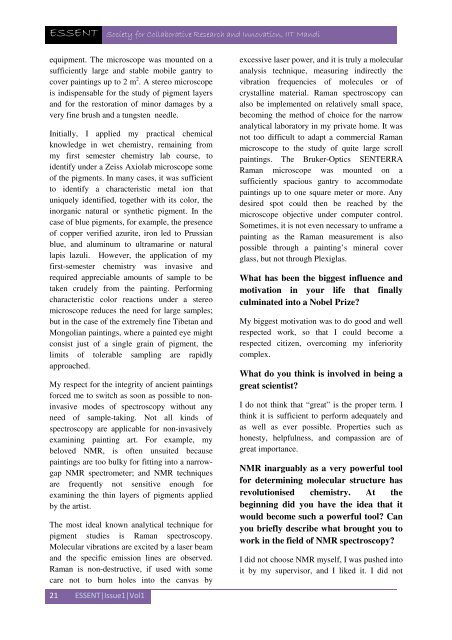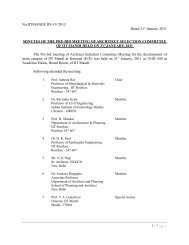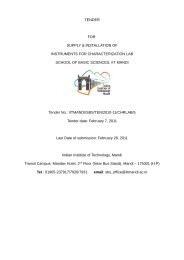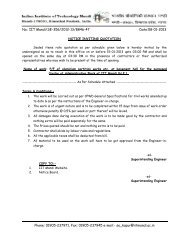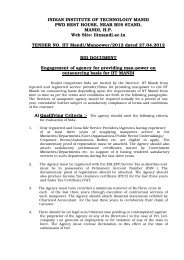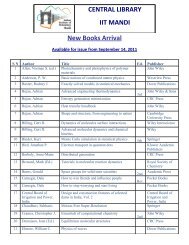Issue1. Vol.1 (April, 2013) - IIT Mandi
Issue1. Vol.1 (April, 2013) - IIT Mandi
Issue1. Vol.1 (April, 2013) - IIT Mandi
- No tags were found...
You also want an ePaper? Increase the reach of your titles
YUMPU automatically turns print PDFs into web optimized ePapers that Google loves.
ESSENT Society for Collaborative Research and Innovation, <strong>IIT</strong> <strong>Mandi</strong>equipment. The microscope was mounted on asufficiently large and stable mobile gantry tocover paintings up to 2 m 2 . A stereo microscopeis indispensable for the study of pigment layersand for the restoration of minor damages by avery fine brush and a tungsten needle.Initially, I applied my practical chemicalknowledge in wet chemistry, remaining frommy first semester chemistry lab course, toidentify under a Zeiss Axiolab microscope someof the pigments. In many cases, it was sufficientto identify a characteristic metal ion thatuniquely identified, together with its color, theinorganic natural or synthetic pigment. In thecase of blue pigments, for example, the presenceof copper verified azurite, iron led to Prussianblue, and aluminum to ultramarine or naturallapis lazuli. However, the application of myfirst-semester chemistry was invasive andrequired appreciable amounts of sample to betaken crudely from the painting. Performingcharacteristic color reactions under a stereomicroscope reduces the need for large samples;but in the case of the extremely fine Tibetan andMongolian paintings, where a painted eye mightconsist just of a single grain of pigment, thelimits of tolerable sampling are rapidlyapproached.My respect for the integrity of ancient paintingsforced me to switch as soon as possible to noninvasivemodes of spectroscopy without anyneed of sample-taking. Not all kinds ofspectroscopy are applicable for non-invasivelyexamining painting art. For example, mybeloved NMR, is often unsuited becausepaintings are too bulky for fitting into a narrowgapNMR spectrometer; and NMR techniquesare frequently not sensitive enough forexamining the thin layers of pigments appliedby the artist.The most ideal known analytical technique forpigment studies is Raman spectroscopy.Molecular vibrations are excited by a laser beamand the specific emission lines are observed.Raman is non-destructive, if used with somecare not to burn holes into the canvas by21 ESSENT|Issue1|Vol1excessive laser power, and it is truly a molecularanalysis technique, measuring indirectly thevibration frequencies of molecules or ofcrystalline material. Raman spectroscopy canalso be implemented on relatively small space,becoming the method of choice for the narrowanalytical laboratory in my private home. It wasnot too difficult to adapt a commercial Ramanmicroscope to the study of quite large scrollpaintings. The Bruker-Optics SENTERRARaman microscope was mounted on asufficiently spacious gantry to accommodatepaintings up to one square meter or more. Anydesired spot could then be reached by themicroscope objective under computer control.Sometimes, it is not even necessary to unframe apainting as the Raman measurement is alsopossible through a painting’s mineral coverglass, but not through Plexiglas.What has been the biggest influence andmotivation in your life that finallyculminated into a Nobel Prize?My biggest motivation was to do good and wellrespected work, so that I could become arespected citizen, overcoming my inferioritycomplex.What do you think is involved in being agreat scientist?I do not think that “great” is the proper term. Ithink it is sufficient to perform adequately andas well as ever possible. Properties such ashonesty, helpfulness, and compassion are ofgreat importance.NMR inarguably as a very powerful toolfor determining molecular structure hasrevolutionised chemistry. At thebeginning did you have the idea that itwould become such a powerful tool? Canyou briefly describe what brought you towork in the field of NMR spectroscopy?I did not choose NMR myself, I was pushed intoit by my supervisor, and I liked it. I did not


